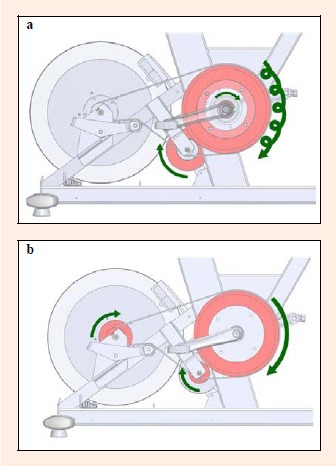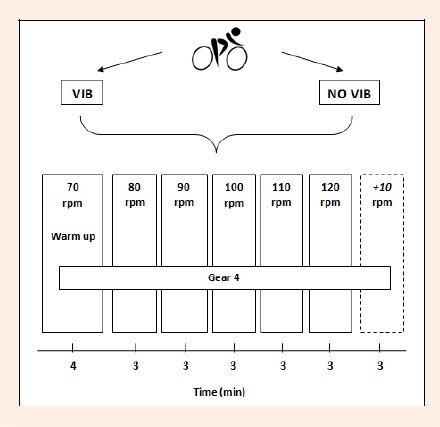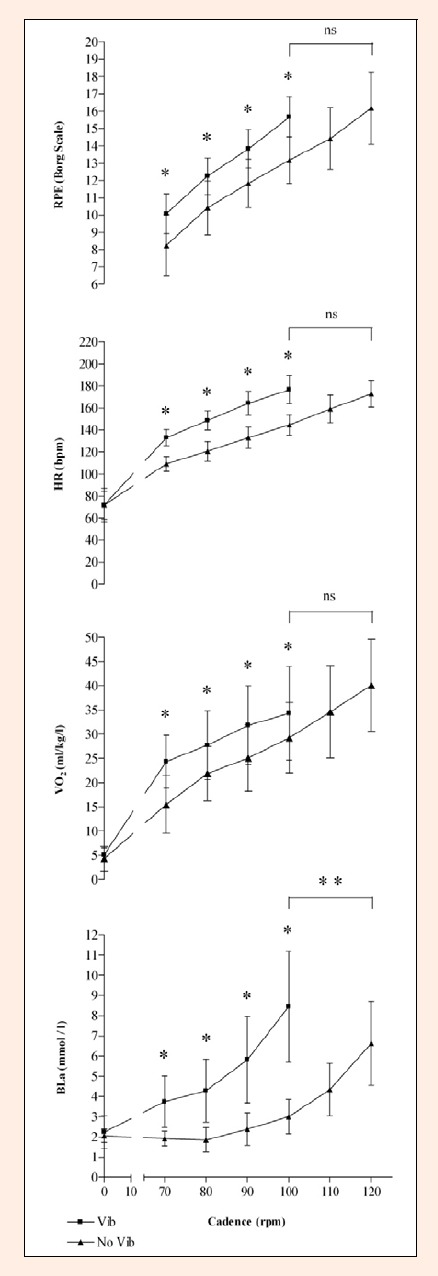Abstract
Whole Body Vibration training is studied and used in different areas, related to sport performance and rehabilitation. However, few studies have investigated the effects of Vibration (Vib) exposure on aerobic performance through the application of this concept to cycling exercise. A specifically designed vibrating cycloergometer, the powerBIKE™, was used to compare the effects of Vib cycling exercise and normal cycling on different physiological parameters during maximal graded exercise test. Twelve recreationally active male adults (25 ± 4.8 yrs; 181.33 ± 5.47 cm; 80.66 ± 11.91 kg) performed two maximal incremental cycling tests with and without Vib in a block-randomized order. The protocol consisted of a 4 min warm up at 70 rev·min-1 followed by incremental steps of 3 min each. Cycling cadence was increased at each step by 10 rev·min-1 until participants reached their volitional exhaustion. Respiratory gases (VO2, VCO2), Heart Rate, Blood Lactate and RPE were collected during the test. Paired t-tests and Cor-relation Coefficients were used for statistical analysis. A significantly greater (P<0.05) response in the VO2, HR, BLa and RPE was observed during the Vib trial compare to normal cycling. No significant differences were found in the maximal aerobic power (Vib 34.32 ± 9.70 ml·kg-1·min-1; no Vib 40.11 ± 9.49 ml·kg-1·min-1). Adding Vib to cycling exercise seems eliciting a quicker energetic demand during maximal exercise. However, mechanical limitations of the vibrating prototype could have affected the final outcomes. Future studies with more comparative setting are recommended to deeply appraise this concept.
Key points
There is strong evidence to suggest that acute indirect vibrations act on muscle to enhance force, power, flexibility, balance and proprioception.
There is a lack of knowledge regarding the effects of applying Vib to dynamic aerobic exercise.
Added vibrations to cycling exercise seem producing a quicker energetic demand during maximal graded exercise when compared to traditional cycling.
Key words: Vibration, Endurance, Aerobic, Energetic demand, Cycloergometer
Introduction
Vibration (Vib) can be defined as a mechanical stimulus that may affect the musculoskeletal system totally (Whole Body Vibration, WBV) or locally (Local Body Vibration, LBV) (Cochrane, 2011a; Miyashita et al., 1992). Vib(s) are naturally generated during any activity of the body resulting in impacts with the floor, such as walking or running (Cardinale and Wakeling, 2005); furthermore, artificial generated Vib(s) are produced by several equipments (i.e. pneumatic drills, vibrating platforms) and in different work conditions (i.e. truck and bus drivers). However, different types and amounts of Vib have been shown to produce significantly different effects on human body’s performance (Rittweger, 2010). In this context, the exposure to a low frequency Vib (5-45 Hz) has been shown to elicit an increase in muscular activity (Cochrane, 2011b). It has been suggested that Vib can activate the proprioceptive sensory system, which is based on the excitation of Ia afferent signals situated at the neuromuscular spindle. This, in turn, activates larger motoneurons and leads to the recruitment of previously inactive muscle fibers (Iodice et al., 2010). In addition, the body has a strategy of “tuning” its muscle activity to reduce Vib on the soft and muscle tissue (Cardinale and Wakeling, 2005). Indeed a maximally activated muscle can reduce the amount of free Vib, as the tissue "oscillations" are virtually eliminated after a couple of muscle contraction cycles (Delecluse et al., 2003). It is thus possible that the increase in the motor units recruitment activated by a reflex action is a natural response of the body to minimize Vib within the tissues.
The possibility to elicit a greater muscle activity (Rittweger, 2010) followed by an increase in tissue oxygenation (Coza et al., 2011) and muscle blood flow (Herrero et al., 2010) drove the interest on Vib as a po-tential alternative to more traditional training methods (Delecluse et al., 2003).
The use of Vib during exercise has been made possible by the simultaneous development of specific training devices able to transmit Vib to the whole body and/or locally (Cochrane, 2011a; Miyashita et al., 1992). These devices fall into two main categories: vibrating platforms, and local Vib devices (Cochrane, 2011a).
Although the results of many studies showed enhancements of several physiological responses due to the exposure to specific exercise protocols endorsing the use of vibrating platforms (de Hoyo Lora et al., 2010; Maikala and Bhambhani, 2008; Rittweger et al., 2002; Sands et al., 2006; 2008; Suhr, 2007), these devices cannot be considered the optimal training devices for enhancing the aerobic endurance performance (Cochrane, 2011a). Therefore, as the aerobic training plays the most important role in enhancing the cardio respiratory fitness (CRF), a critical predictor of health risks (Bianco et al., 2010; Colberg et al., 2010), alternative ways were investigated to apply the superimposed vibratory stimulus to aerobic exercise. However, less than a handful of studies applied Vib during cycling exercise as an innovative approach to training and performance. Sperlich et al., 2009 observed an increase in the maximal oxygen consumption (VO2max) and the aerobic performance in 12 participants performing a maximal incremental cycling test with Vib compared to normal cycling. The bike’s frame was mounted on a vibrating platform but only the crank was connected to the vibrating source, transmitting the Vib to the lower limbs. Suhr et al., 2007, focused on the effects of cycling with and without Vib in normoxic and hypoxic conditions on several angiogenesis parameters. The results showed that both Vib and hypoxia were effective stimuli for the angiogenesis process. The authors concluded that the effects of the increased maximal shear stress at the vessel wall, as result of mechanical Vib, might have represented a significant stimulus for the release of several mediators/inductors of angiogenesis.
To date, only Samuelson et al., 1989 observed that imposed Vib reduces the work capacity during an incremental cycling exercise to exhaustion. Seeing the early stage of the research within this area, a firm conclusion cannot be drawn on the effects of this new concept and a deeper understanding of the phenomenon is still needed. Therefore, the focus of the present study is to monitor the physiological mechanisms related to adding Vib to cycling exercise using a specifically designed vibrating cycloergometer called powerBIKE™. This study aims to assess the impact of "added" Vib to cycling on the physiological parameters relative to the cardiovascular, pulmonary and energetic systems, compared to traditional cycling.
Methods
Participants
Twelve healthy and active males (performing at least 3 hours/week of team sport activities such as football and basketball for at least one year) volunteered to participate in this study. Participants’ characteristics were: age 25.0 ± 4.8 yrs; height 1.81 ± 0.05 m; weight 80.66 ± 11.91 kg. A signed consent was obtained from each participant prior to testing. The study obtained the approval of The University of Greenwich Research Ethics Committee. All tests took place within the Sport Science Laboratories.
The vibrating cycle ergometer
All exercise tests were performed on the powerBIKE™ (Power Plate International Ltd, London, UK) a stationary bike that allows Vib cycling and/or traditional cycling.
The ergometer had seven resistance levels (gears) based on a magnetic system applied to the flywheel. A manual command based in the handle bar altered the position of the magnet, increasing or decreasing the workload. The second manual command in the handle bar activated or deactivated the Vib mechanism located in the bike’s crank. When the system was engaged, Vib was transmitted from the crank to the pedals to the lower limbs. When the Vib system was not engaged the housing was still and the crank and pedals rotated in a perfect circle (Figure 1). The crank (axis) sat in an eccentric housing. When the Vib system was engaged, the clutch system drove to a second belt that was connected to the housing and started to rotate (20 times per revolution); this mechanism caused the crank and pedals to move off the rotation centre and to vibrate while pedalling. The frequency (f) of the transmitted Vib was speed based, and it increased according to the cycling cadence (i.e. 60 to 130 rev·min-1; 23.3 to 43.3 Hz). The peak to peak displacement was set at 2 mm. The bike’s frame was designed to insulate the handlebar and the seat from transmitting the Vib to the rest of the body. The Manufacturer provided the above mentioned data as result of specific measurements, involving the use of accelerometers located on the bike’s pedals, performed on the prototype used in the presented research. Furthermore, data were provided in support of the consistency of the bike’s power output between Vib and no Vib.
Figure 1.

Vibration system on: vibration cycling; (b) Vibration system off: traditional cycling.
Testing protocol
Each participant performed two maximal incremental cycling exercise tests (with and without Vib) in a randomized block order, on two different days, at the same time of the day, with a recovery ranging from 72 to 96 hours. The randomized block design resulted in the achievement of an equal number of participants starting the experimentation with as well without Vib. This design was considered to be sufficiently effective in reducing the contribution to experimental error of any order effect of testing.
Participants were invited not to change their food habits during the intervention and were instructed to have their last meal two hours minimum before testing. They have also been asked to refrain from any physical activity in the 24 hours before each test.
The protocol started with 4 min warm up (WU) at 70 rev·min-1; the resistance level was set at gear 4. The cadence was then increased by 10 rev·min-1 every 3 min until the participant was unable to maintain it (exhaustion) (Figure 2). After several pilot trials and in the light of the data provided by the Manufacturer, the above mentioned setting was considered as the optimal to assure a consistent and comparable exercise protocol. The powerBIKE™ was set according to participants’ physiognomy: the height of the seat, distance between the handle bar and the seat, seat to centre of the crank, handle bar to the centre of the crank and handle bar to floor, recorded and applied identically at each trial. Oxygen uptake (VO2), carbon dioxide production (VCO2), respiratory exchange ratio (RER) and minute ventilation (VE) were continuously measured using an online gas analyzer (VacuMed, mini-CPX, USA) during the protocol; values were then averaged every 30 s. A five μL blood sample was collected from the fingertip at rest and at the last 30 s of each stage of the exercise test. Samples were analysed for blood lactate (BLa) concentration using a lactate analyser (Biosen EKF diagnostic, Germany). Similarly, heart rate (HR) was continuously monitored using a HR monitor (Polar, Finland) then averaged for the last 30 s of each step; maximal HR was retained at the end of the test (HRmax).
Figure 2.

The experimental incremental protocol: maximal graded cycling exercise with / without Vib.
Likewise, the rate of perceived exertion (RPE) was recorded during the last 30 s of each stage of the exercise protocol and at the end of the tests (RPEmax) using the Borg Scale (6 to 20) (Borg, 1970).
Metabolic thresholds
Two metabolic thresholds were analysed: the onset of blood lactate accumulation (OBLA) and the ventilatory threshold (VT). Their respective percentages of VO2max and HRmax as well as BLa and RPE corresponding values were calculated for comparison.
Statistical analysis
All collected data were analysed for means values and standard deviations. Paired t-tests were used to compare VO2, HR, BLa and RPE during the Vib / no Vib conditions. Multiple Pearson correlation analyses were performed to assess the relations between the data. SPSS statistics package software version 18 for Windows® was used to perform the analysis. Statistical significance was accepted at p < 0.05.
Results
Cardio respiratory and cardio vascular performance
A significantly higher VO2 (p < 0.05) was measured during the first four stages (70, 80, 90 and 100 rev·min-1) of the Vib trial compared to no Vib (p = 0.0003; p = 0.0021; p = 0.0014; p = 0.0204).
No significant difference was found in the VO2max (p = 0.1631) reached by the participants during the Vib trial when compared to no Vib (34.32 ± 9.7 and 40.11 ± 9.49 ml·kg-1·min-1 respectively). The VO2max was reached at an average of 100 rev·min-1 with Vib and 120 rev·min-1 without Vib.
HR values are shown in Figure 3. Resting HR was similar before both trials, however, it was significantly higher during the first, second, third and fourth stages (70, 80, 90, 100 rev·min-1) of the Vib trial compared to the no Vib (p < 0.0001; p < 0.0001; p < 0.0001; p < 0.0001 respectively). HRmax did not statistically differ (p = 0.488) between the Vib and the no Vib trials (177 ± 13 and 181 ± 16 beats·min-1 respectively).
Figure 3.

Oxygen consumption, HR adaptations, BLa response and RPE scores during maximal exercise with / without Vib.* significant at p < 0.05; ** significant maximal values at p < 0.05; ns: not significant.
Metabolic performance
Figure 3 shows the BLa measured during each stage of both trials. A typical exponential trend was noticed, consisting of an initial steady state followed by a significant increase due to the increased exercise intensity.
BLa concentration was significantly higher during the first, second, third and fourth stages (70, 80, 90, 100 rev·min-1) of the Vib trial compared to the no Vib trial (p = 0.0006; p < 0.0001; p < 0.0001; p < 0.0001 respectively).
The maximal lactate concentration (BLamax) measured at the end of each trial was found significantly higher (p = 0.0129) after the Vib trial (14.05 ± 2.86 mmol·l-1) compared to no Vib (11.31 ± 3.44 mmol·l-1).
The OBLA and the VT were reached between the first and the second stage (70-80 rev·min-1), during the Vib trail, and between the third and fourth (100-110 rev·min-1) during the no Vib trial.
The corresponding VO2 and HR at the OBLA and VT point were found to be significantly lower (p = 0.041 and p = 0.03 respectively) during the Vib trial compared to no Vib, and similarly for the percentage of HRmax at which the OBLA and VT occurred (p = 0.0085); the corresponding percentage of VO2max was found to be not significantly different (p = 0.072) between Vib and no Vib (Table 1).
Table 1.
OBLA, VT and relative values during maximal exercise with / without Vib. Data are means (±SD).
| OBLA / VT | Vib | no Vib |
|---|---|---|
| Stage | WU-1 | 3-4 |
| Cadence (rpm) | 70-80 | 100-110 |
| Time (min) | 6 | 15 |
| VO2 (ml·kg-1·min-1) | 26.0 (6.2) | 31.9 (8.4) * |
| HR (bpm) | 141 (8) | 152 (11) * |
| RPE (Borg scale) | 11.0 (1.1) | 13.0 (1.6) * |
| % VO2max | 76% | 80% * |
| % HRmax | 80% | 89% * |
* p < 0.05
Perceived effort
RPE was significantly higher throughout the Vib trial (70, 80, 90 and 100 rev·min-1) compared to no Vib (P=0.0138; P=0.0092; P=0.0024; P=0.0005 respectively) (Figure 3). No significant differences in the RPEmax (p = 0.5992) were found at the end of both trials (15.67 ± 1.15 and 16.18 ± 2.31 for Vib and no Vib respectively).
Correlation analysis
Pearson correlation analyses were performed between BLa, HR, VO2, VE and RPE for both Vib and no Vib trials. Data showed generally high correlation coefficients between the variables for both Vib (minimum r = 0.87; maximum r = 0.99) and no Vib trials (min r = 0.79; maximum r = 0.99).
All relations were statistically significant (p < 0.05) in both Vib/no Vib trial, apart for the BLa that, in the Vib trial, was found to be not significantly correlated (p > 0.05) to HR, VO2 and RPE values. Ultimately, the average duration of the Vib trial was found to be significantly shorter (9 min) when compared to no Vib (15 min).
Discussion
This study represents the first experimental approach based on the application of the Vib cycling exercise (VCE) concept through the use of a specifically designed vibrating cycling ergometer.
Compared to traditional cycling, adding Vib to cycling exercise didn’t result in any significant variation of the VO2max. This outcome is aligned to the results of other works reporting that a single acute bout of exercise might not represent a sufficient stimulus to significantly increase the maximal aerobic capacity (Garber et al., 2011; Midgley et al., 2006). The VO2max is indeed a strongly fitness level-related parameter and it may be difficult to precisely define an exact threshold to improve the cardio respiratory fitness, especially in fit individuals as the ones who took part in this study. Furthermore, no differences were found in the HRmax between trials. This result supports the previously mentioned inefficacy of a single bout of exercise in producing a significant improvement in the performance of the cardio respiratory system and it further strengthen the well-known linear relation correlating the pulmonary to the cardiac output (Miller, Wallace and Eggert, 1993). The RPEmax scored at the end of each trial confirms the largely credited parallelism between the magnitude of the exercise-induced physiological responses and the psychological perception of the effort required to sustain the exercise (Borg et al., 1987; Lagally et al., 2002). The above mentioned inter-relations between variables found further experimental support in the results of the correlation analyses, showing generally high and statistically significant coefficients.
The BLamax was the only variable to highlight a difference in terms of peak values reached by the physiological parameters between the two trials, as it resulted to be significantly enhanced by the exposure to Vib.
However, although the Vib exposure didn’t produce significantly different effects in the peak values of almost all the monitored responses, it significantly influenced the way and the time these parameters reached their maximum. The Vib exposure produced a greater demand to the body in terms of aerobic and an-aerobic power during the exercise, increasing the cardio vascular effort and decreasing the time to fatigue as shown by: 1. the significantly greater VO2, HR, BLa and RPE values recorded during all the submaximal steps of the exercise protocol with Vib; 2. the significantly lower values of VO2, HR and BLa at which the OBLA and the VE were reached; 3. the anticipated exhaustion obtained by the participant, reached at an average of 100 rev·min-1 (3rd step) during the Vib trial (translating into an average duration of 9 min) and at an average of 120 rev·min-1 (5th step) during the no Vib trial (translating into an average duration of 15 min).
These findings seem suggesting that the application of the Vib as an external stimulus produced a significantly greater and quicker energetic demand to the body and thus it was perceived as a greater workload. It might be therefore hypothesized that this "added workload", represented by the vibratory stimulus, speeded up the physiological responses of the cardiovascular and pulmonary systems, primary increasing the contribution of the anaerobic system to the exercise performance, as confirmed by the significantly greater BLamax values reached at the end of the Vib trial. It has been suggested that the increased neuromuscular units recruitment resulting from the exposure to Vib primary involves the fast twitch muscle fibers (type IIa - IIb) (Cochrane, 2011b), known to play a role in high intensity muscle contractions (Fitts and Widrick, 1996). The biological functioning of these muscle fibers is mainly based on a glicolityc pathway and thus they have been identified as the main responsible for the BLa production and accumulation (Putman et al., 2004; Russell et al., 2003). BLa is known being a central player in the integration of the metabolic response to exercise, affecting the acidosis (Kohn et al., 2011), a well-known process related to high BLa concentrations generated by high intensity muscle contractions. This process, slowing down the glycolisis, is considered to play a role in the onset of the peripheral fatigue, a limiting factor of performance (Chmura and Nazar, 2010). Therefore, this physiological mechanism might explain the anticipated fatigue experienced by the participants during the Vib trial as result of an increased muscular demand produced by the particular Vib exercise protocol used in this study.
However, the increased acidosis generated during the Vib trial might be not the only cause of the anticipated skeletal muscle fatigue. Vib might affect the muscle fatigue in different ways. Cardinale and Wakeling, 2005 showed that a relatively long exposure to Vib, generally more than 7 min leads to a decreased power and force production. Authors reported that an acute reduction in maximal voluntary knee extension force and a depression of the voluntary activation of the leg extensor muscles up to 180 min after an exercise bout were obtained in participants exercising on a vibrating platform. This observation might be aligned to the work conducted by Samuelson et al., 1989 who showed that Vib can negatively affect cycling performance in terms of exercise duration when exercising at a constant submaximal workload. Authors hypothesized that the local responses within the working muscles, rather than the central physiological adaptations, might be responsible of this effect. Contrasting results to the present study were found by Sperlich et al., 2009 who found the application of Vib during cycling exercise to result in a significantly increased VO2max. However, in the mentioned study a different f of Vib and peak-to-peak displacement was used (20 Hz and 4mm). The parameters used in the present study (23.3 up to 33.3 Hz and 2mm) are aligned to the range of f (25-45 Hz) and peak to peak displacement (2-10 mm) that to date have been considered to produce the most appreciable effects in terms of increased muscle activity (Cochrane, 2011b). However, because it has been shown that different f(s), peak to peak displacements and exposure times can significantly affect the outcomes of a Vib exposure (Yue and Mester, 2007), it is reasonable hypothesizing that the differences in the type of Vib used in the two studies might have played a role in producing different physiological responses.
Conclusion
The primary aim of this study was to evaluate the effects of VCE on different physiological parameters during a maximal graded exercise test. The experimental hypothesis stated that the VCE performed on the powerBIKE™ would have produced a significant variation in the monitored physiological parameters compared to the effects of traditional cycling. The results of this study confirm this hypothesis in terms of the increased energetic demand generated by the Vib exposure. Indeed, the cardiovascular and metabolic adaptations have been significantly enhanced by the application of the vibratory stimulus during the maximal graded test at any submaximal workload. Although the maximal aerobic performance (VO2max) has not been significantly affected, the VCE has been proved to represent a greater exercising stimulus for the whole body, speeding the obtainment of the metabolic thresholds (OBLA and VT) up and increasing the effort required by the participants.
However, the absence of a direct monitoring of the characteristics of the Vib produced by the prototype during the experimentation can be considered the main limit of the study. Indeed, investigators cannot exclude that the Vib system might have produced a variation in the Vib characteristics from the values provided by the Manufacturer, specifically when engaged during the exercise performance, as it was in an early stage of its development. This fact represents the main reason for suggesting that more studies, with more comparative settings, are needed in order to draw a more comprehensive conclusion on the effects of this concept.
The knowledge produced in this study about this specific vibrating ergometer might be considered the result of a pilot intervention in support of the development of future, more comparative studies. The application of the Vib concept to cycling exercise still represents an interesting possibility for the evaluation of the potential benefits of Vib on strength, bone mineral density (BMD), cardio respiratory fitness (CRF), blood flow, angiogenesis factors, hormonal regulation and several other parameters related to the human performance.
Furthermore, the development of new strategies in the treatment of different diseases (i.e. cardio vascular diseases) might be supported by the implementation of new, low impact and effective exercise methods, such as the one represented by the cycling exercise added with Vib.
For these reasons, a deeper understanding of the effects of the VCE on the human body is still needed and recommended.
Acknowledgements
The authors acknowledge the Power Plate International Ltd (London, UK) for providing the vibrating cycle ergometer prototype used in the presented intervention. The results of the present study do not constitute endorsement of the prototype by the authors or the journal. The experiment complies with the current laws of the United Kingdom, in which it was performed.
Biographies

Davide Filingeri
Employment
PhD Candidate at Loughborough University
Degree
MSc
Research interests
Environmental exercise physiology, sport performance, health & fitness.
E-mail: davidefilingeri@hotmail.it

Monèm Jemni
Employment
Associate Professor at the University of Greenwich
Degree
PhD
Research interests
Physiological aspects of human performance with a special recent interest in health and exercise science.
E-mail: m.jemni@gre.ac.uk

Antonino Bianco
Employment
Assistant Professor at University of Palermo, Department of Sports Science (DISMOT)
Degree
PhD
Research interests
Personal training, strength and conditioning, performance, exercise physiology.
E-mail: antoninobianco@unipa.it

Edzard Zeinstra
Employment
Research Director at Power Plate International Ltd and PhD student at the Center for Behavorial Neurobiology at the University of Groningen, The Netherlands
Degree
MSc
Research interests
Vibration training; health & fitness; healthy aging; exercise, brain & cognition.
E-mail: E.B.Zeinstra@rug.nl

Alfonso Jimenez
Employment
Professor of Sports Sciences, Head of the Institute of Sports, Exercise and Active Living (ISEAL), Victoria University of Melbourne, Australia and Chairman of the Standards Council at the European Health & Fitness Association
Degree
PhD
Research interests
Resistance training and health, worksite health promotion and clinical exercise.
E-mail: a.jimenez@gre.ac.uk
References
- Bianco A., Bellafiore M., Battaglia G., Paoli A., Caramazza G., Farina F., Palma A.(2010) The effects of indoor cycling training in sedentary overweight women. Journal of Sports Medicine and Physical Fitness 550, 159–65 [PubMed] [Google Scholar]
- Borg G.(1970) Perceived exertion as an indicator of somatic stress. Scandinavian Journal of Rehabilitation Medicine 22, 92–98 [PubMed] [Google Scholar]
- Borg G., Hassmen P., Lagerstrom M.(1987) Perceived exertion related to heart rate and blood lactate during arm and leg exercise. European Journal of Applied Physiology and Occupational Physiology 556, 679–685 [DOI] [PubMed] [Google Scholar]
- Cardinale M., Wakeling J.(2005)Whole body vibration exercise: are vibrations good for you? British Journal of Sports Medicine 39, 585–589 [DOI] [PMC free article] [PubMed] [Google Scholar]
- Chmura J., Nazar K.(2010) Parallel changes in the onset of blood lactate accumulation (OBLA) and threshold of psychomotor performance deterioration during incremental exercise after training in athletes. International Journal of Psychophysiology 75, 87–90 [DOI] [PubMed] [Google Scholar]
- Cochrane D.J.(2011a) Vibration exercise: the potential benefits. International Journal of Sports Medicine 332, 75–99 [DOI] [PubMed] [Google Scholar]
- Cochrane D.J.(2011b) The potential neural mechanisms of acute indirect vibration. Journal of Sports Science and Medicine 110, 19–30 [PMC free article] [PubMed] [Google Scholar]
- Colberg S.R., Sigal R.J., Fernhall B., Regensteiner J.G., Blissmer B.J., Rubin R.R., Chasan-Taber L., Albright A.L., Braun B.(2010) Exercise and type 2 diabetes: the American College of Sports Medicine and the American Diabetes Association: joint position statement. Diabetes Care. Diabetes Care 33, 147–67 [DOI] [PMC free article] [PubMed] [Google Scholar]
- Coza A., Nigg B.M., Dunn J.F.(2011) Effects of vibrations on gastrocnemius medialis tissue oxygenation. Medicine & Science in Sports & Exercise 443, 509–515 [DOI] [PubMed] [Google Scholar]
- de Hoyo Lora M., Sañudo Corrales B., Carrasco Páez L. (2010) Cardiovascular and respiratory response resulting from the application of vibratory stimuli with different magnitudes. Apunts. Medicina de l'Esport 445, 23 (In Spanish: English abstract). [Google Scholar]
- Delecluse C., Roelants M., Verschueren S.(2003) Strength increase after whole-body vibration compared with resistance training. Medicine & Science in Sports & Exercise 335, 1033-1041 [DOI] [PubMed] [Google Scholar]
- Fitts R.H., Widrick J.J.(1996) Muscle mechanics: adaptations with exercise-training. Exercise and Sport Sciences Reviews 224, 427–473 [PubMed] [Google Scholar]
- Garber C.E., Blissmer B., Deschenes M.R., Franklin B.A., Lamonte M.J., Lee I.M., Nieman D.C., Swain D.P.(2011) American College of Sports Medicine position stand. Quantity and quality of exercise for developing and maintaining cardiorespiratory, musculoskeletal, and neuromotor fitness in apparently healthy adults: guidance for prescribing exercise. Medicine & Science in Sports & Exercise 43, 1334-1359 [DOI] [PubMed] [Google Scholar]
- Herrero A.J., Menendez H., Gil L., Martin J., Martin T., Garcia-Lopez D., Gil-Agudo A., Marin P.J.(2010) Effects of whole-body vibration on blood flow and neuromuscular activity in spinal cord injury. Spinal Cord 49, 554–559 [DOI] [PubMed] [Google Scholar]
- Iodice P., Bellomo R. G., Gialluca G., Fano G., Saggini R.(2010) Acute and cumulative effects of focused high-frequency vibrations on the endocrine system and muscle strength. European Journal of Applied Physiology 1111, 897–904 [DOI] [PubMed] [Google Scholar]
- Kohn T.A., Essen-Gustavsson B., Myburgh K.H.(2011) Specific muscle adaptations in type II fibers after high-intensity interval training of well-trained runners. Scandinavian Journal of Medicine & Science in Sports 21(6), 765–772 [DOI] [PubMed] [Google Scholar]
- Lagally K.M., Robertson R.J., Gallagher K.I., Goss F.L., Jakicic J.M., Lephart S.M., McCaw S.T., Goodpaster B.(2002) Perceived exertion, electromyography, and blood lactate during acute bouts of resistance exercise. Medicine & Science in Sports & Exercise 334, 552–559 [DOI] [PubMed] [Google Scholar]
- Maikala R.V., Bhambhani Y.N.(2008) Cardiovascular responses in healthy young women during exposure to whole-body vibration. International Journal of Industrial Ergonomics 338, 775 [Google Scholar]
- Midgley A.W., McNaughton L.R., Wilkinson M.(2006) Is there an optimal training intensity for enhancing the maximal oxygen uptake of distance runners? Empirical research findings, current opinions, physiological rationale and practical recommendations. Sports Medicine 36, 117–132 [DOI] [PubMed] [Google Scholar]
- Miller W.C., Wallace J.P., Eggert K.E.(1993) Predicting max HR and the HR-VO2 relationship for exercise prescription in obesity. Medicine & Science in Sports & Exercise 225, 1077-1081 [PubMed] [Google Scholar]
- Miyashita K., Morioka I., Tanabe T., Iwata H., Takeda S.(1992) Symptoms of construction workers exposed to whole body vibration and local vibration. International Archives of Occupational and Environmental Health 664, 347–351 [DOI] [PubMed] [Google Scholar]
- Peronnet F., Aguilaniu B.(2006) Lactic acid buffering, nonmetabolic CO2 and exercise hyperventilation: a critical reappraisal. Respiratory Physiology & Neurobiology 150, 4–18 [DOI] [PubMed] [Google Scholar]
- Putman C.T., Xu X., Gillies E., MacLean I.M., Bell G.J.(2004) Effects of strength, endurance and combined training on myosin heavy chain content and fibre-type distribution in humans. European Journal of Applied Physiology 992, 376–384 [DOI] [PubMed] [Google Scholar]
- Rittweger J.(2010) Vibration as an exercise modality: how it may work, and what its potential might be. European Journal of Applied Physiology 1108, 877–904 [DOI] [PubMed] [Google Scholar]
- Rittweger J., Ehrig J., Just K., Mutschelknauss M., Kirsch K.A., Felsenberg D.(2002) Oxygen uptake in whole-body vibration exercise: influence of vibration frequency, amplitude, and external load. International Journal of Sports Medicine 223, 428–432 [DOI] [PubMed] [Google Scholar]
- Russell A.P., Wadley G., Hesselink M.K., Schaart G., Lo S., Leger B., Garnham A., Kornips E., Cameron-Smith D., Giacobino J.P., Muzzin P., Snow R., Schrauwen P.(2003). UCP3 protein expression is lower in type I, IIa and IIx muscle fiber types of endurance-trained compared to untrained subjects. Pflügers Archiv European Journal of Physiology 4445, 563–569 [DOI] [PubMed] [Google Scholar]
- Samuelson B., Jorfeldt L., Ahlborg B.(1989) Influence of vibration on work performance during ergometer cycling. Upsala Journal of Medical Sciences 94, 73–79 [DOI] [PubMed] [Google Scholar]
- Sands W.A., McNeal J., Stone M.H., Kimmel W., Haff G.G., Jemnì M.(2008) The effect of vibration on active and passive range of motion in elite female synchronized swimmers. European Journal of Sport Science 8, 217–223 [Google Scholar]
- Sands W.A., McNeal J.R., Stone M.H., Russell E.M., Jemni M.(2006) Flexibility enhancement with vibration: Acute and long-term. Medicine & Science in Sports & Exercise, 38, 720–725 [DOI] [PubMed] [Google Scholar]
- Sperlich B., Kleinoeder H., De Marées M., Quarz D., Linville J., Haegele M., Mester J.(2009) Physiological and perceptual responses of adding vibration to cycling. Journal of Exercise Physiology online, 112, 40–46 [Google Scholar]
- Suhr F., Brixius K., de Marees M., Bolck B., Kleinoder H., Achtzehn S., Bloch W., Mester J.(2007) Effects of short-term vibration and hypoxia during high-intensity cycling exercise on circulating levels of angiogenic regulators in humans. Journal of Applied Physiology 103, 474–483 [DOI] [PubMed] [Google Scholar]
- Yue Z., Mester J.(2007) On the cardiovascular effects of whole-body vibration part I. Longitudinal effects: hydrodynamic analysis. Studies in Applied Mathematics 1119, 95–119 [Google Scholar]


